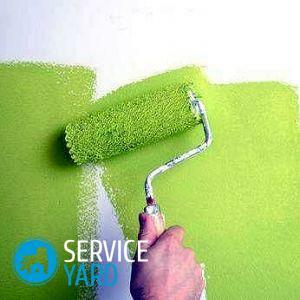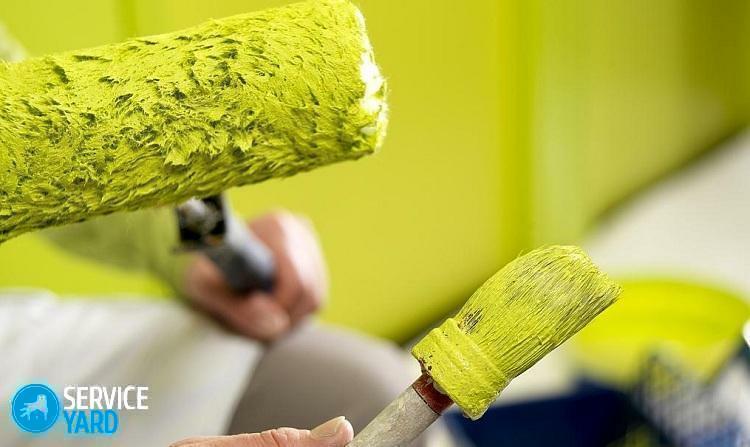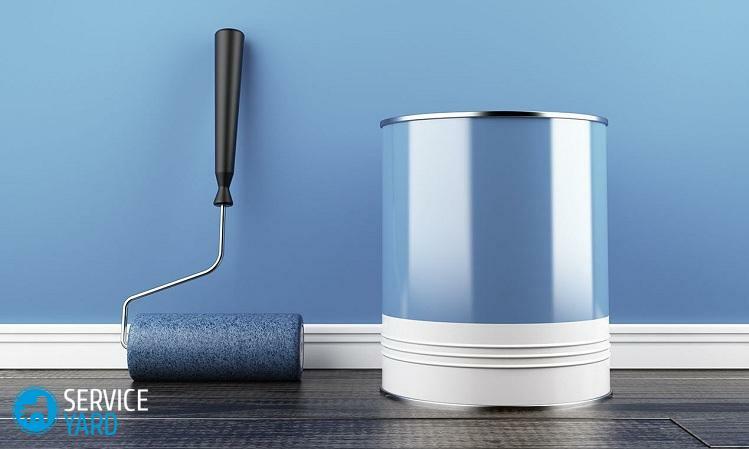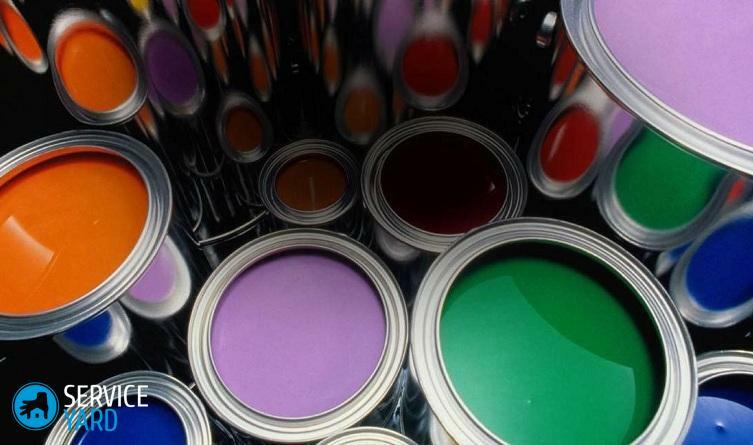
- Wall paint in the apartment: the choice of the composition
- Interior paint
- Bathroom, kitchen and corridor paints
- Which color is the best color for the room?
- Painting of walls in a room by yourself
You can not even imagine how easily and quickly you can create a unique interior by painting the walls in the apartment! Of course, this method is not as popular as wallpaper, and often people do not view paint as an option for finishing the walls. But in vain! We will tell you how and how paint to paint the walls in the apartment and to give the house an exquisite and fashionable character.
to content ↑Paint for walls in the apartment: choice of composition
Painting the walls in the room is a rather popular alternative to wallpaper. This does not require special skills - the process of covering the walls is fairly simple and convenient. And the result is very beautiful. If you approach the design of an apartment using modern design ideas, you will get an exclusive and beautiful interior.
When taking care of repairing your house, and deciding to use paint as the main finishing material of walls, it is important to determine which paint is better to paint the walls in the apartment. One of the decisive criteria for choosing is which room you have chosen for painting:
- For the bathroom, it is best to purchase moisture-resistant materials.
- In the kitchen it is desirable to use a washable and wear-resistant coating.
- In the living room and bedroom an important factor is the environmental friendliness and safety of the paint.
Important! The matte varnish will visually improve the surface condition of the wall, but glossy material is applied only on absolutely flat plane.
So, what color paint the walls in the apartment, and what sorts of it are?

Water-based paints
These materials include a polyvinyl acetate substance, more commonly known as PVA.This paint is relatively inexpensive and easily accessible to the buyer.
The advantages of this finishing material are:
- Easy application.
- There is no need for multi-layered walls. It will be optimal to paint the surface two times.
- Due to its characteristics it can be used in living rooms - bedroom and nursery.
- The paint has excellent vapor permeability and is considered "breathable".
- A huge range of color palette for every taste.
- If necessary, the walls can be "tinted" to hide the appearing scuffs and stains.
Of the minuses can be designated:
- Exposure to mechanical damage. The paint is easily scratched.
- Apply water emulsion only on carefully prepared walls, perfectly even and smooth.
- Do not wash with water or detergent, especially aggressive or abrasive agents.
Water dispersing compositions
Painting of walls in a room can be carried out with the help of this type of paint, which is divided into the following types:
- Based on acrylic resins. This type of material has excellent performance. First of all, the paint is easily and conveniently applied to the surface, perfectly tinted, has a long service life and does not burn out. In contrast to the water-based composition, it is more resistant to mechanical damage, but inferior to vapor permeability. The surface can be washed and used detergents.
Important! With the help of such a paint, you can hide small cracks with dimensions up to 0.7-1 mm.
- Based on silicone. Have the same excellent properties, but more than acrylic. Separately, the ability of the paint to mask cracks up to 2 mm can be distinguished. The paint is not influenced by the influence of ultraviolet, so it can be used for exterior decoration. The only downside is its high price, but the excellent quality is worth it.
Important! Water dispersion materials are recommended for use in dry rooms, while they are perfectly amenable to washing.
Alkyd Compositions
Such materials include alkyd resins. In their consistency, the colors resemble oil mixtures.
Let's dwell on the merits of this option:
- Water resistance.
- Can not be influenced by ultraviolet radiation.
- Not afraid of high temperature conditions.
- Affordable price.
- Average level of vapor permeability.
- Can be painted with a wooden or metal surface.
Important! This finishing material can give the walls a matt, glossy or semi-matt appearance.
There are a number of disadvantages of alkyd compounds:
- Obligatory preparation of the wall surface.
- For the application of this type of paint, it is necessary to dilute the composition with a solvent, which in turn leads to a sharp specific odor during the painting of the walls.
- Relatively short-lived service life, with the passage of time, color saturation is lost.
Latex paints
In order to understand how to paint the walls in the room with latex, you need to know its features.
Unambiguous advantages of this material are its ease of use, high wear resistance, water resistance and property to smooth out minor defects in the surface - cracks and irregularities.
Important! Latex paints are used only for interior finishing, because they react to the influence of ultraviolet.

Paints based on silicates
The main constituent of the material is liquid glass with various additives. This type of paint successfully cope with both internal and external decoration. Advantages of this coating:
- High degree of hygienic material. The mixture is not subject to the appearance and reproduction of harmful bacteria and mold.
- Excellent wear resistance of coating, long service life of about 15-20 years.
- Easy and convenient to use.
- Does not react to ultraviolet.
- "Breathable" surface. The degree of vapor permeability is the highest for this type of paint.
- Flame retardant.
In addition to obvious advantages, it is necessary to note some of the disadvantages of silicate compounds:
- Silicates are completely incompatible with any other coating. Before applying it, the wall surface must be thoroughly cleaned from the previous paint. The same is true in the reverse situation: no other coloring compounds can be applied over the silicate.
Important! Remove the layer of silicate paint is very difficult. If you prefer to periodically update the interior, then this paint is hardly suitable.
- You can only silicate paint with mineral pigments, which limits the color gamut.
- Harmful in the course of surface application. Perform painting work only in a protective form, with the mandatory use of a respirator.
Important! While the composition is not completely dry, it is dangerous to be in the room. The dry surface is absolutely harmless.
Textured paint
A fashionable trend in modern design and a rather young finishing material among paints. Its essence lies in giving the surface a different texture, a certain relief or chaotic textures. Forget the absolutely smooth and smooth wall!
This paint contains an aqueous acrylic dispersion, supplemented with ingredients that create a relief on the surface. These can be mineral fibers, sand or other substances.
Important! A characteristic difference of the texture ink is its thick consistency. In this regard, the wall covering is best done with a spatula, brush or roller.
This decorative painting has a number of advantages:
- Interesting appearance, unusual design. Gives the room its own individual personality and style.
- Depending on the method of applying the paint, its texture changes. There are quite a few design options.
- Wide color palette of shades.
- Versatility. Textured paint can be applied to almost any kind of surfaces: concrete, plaster, gypsum board, particle board, fiberboard. To achieve the maximum effect, it is recommended to treat the walls with a primer.
Important! Textured paint requires a careful and multi-layer application, in addition, in the process of creating a textured surface will need a variety of construction tools.
to the table of contents ↑Interior paint
What paint to paint walls in apartment in living rooms? What to look for and what features are required to be taken into account?
- The main criterion is their absolute harmlessness.
- Washing surface, on the contrary, is not considered popular, except, perhaps, a children's room.
- When decorating living rooms in the house, such colors are demanded for their decorativeness and design. They must have a spectacular exterior appearance, have a wide range of colors and saturation.
The performance characteristics include:
- Resistance to ultraviolet radiation.
- Fast drying.
- No sharp odors during painting.
Important! Above we considered the types of interior paints, their properties and features. The most suitable for living rooms are:
- Paints with a water base.
- Textured decorative materials.
Paints for bathroom, kitchen and corridor
Depending on the type of room, the requirements for finishing are also dependent:
- Kitchen. Due to its purpose, there are conditions of high humidity and temperature changes in this room. It is based on these factors, you must choose the appropriate paint. In addition, it should be washable and not be affected by mechanical damage. Have a high degree of hygiene.
Important! Thus, the most suitable options include: water-based silicone, alkyd mixes, acrylic, silicate paints.
- Bathroom. At its core, the finish of the bathroom is comparable to the requirements for the kitchen. Therefore, the paint to cover the walls in the bathroom is chosen the same.
- The corridor is less susceptible to temperature and moisture, however, they still have a place to be, since cold air can penetrate through the front door, moisture can get from wet clothes and shoes. In addition, the walls of the hall must be durable and resistant to damage. What colors are optimal in such conditions? Alkyd paints, acrylic, silicone.
After you have decided which paint is better to paint the walls in the apartment, you can go to the interior aspects of the repair. Now you should pay attention to color solutions, design ideas and giving the interior a finish.
to the table of contents ↑Which color is the best color for the room?
Most colors give us unlimited possibilities in choosing colors. And depending on the proportion of color, you can adjust the saturation of the hue.
In order to harmonize the tone more harmoniously, you can use special design tables, in which consonant shades are connected.
We advise you in choosing the color to pay attention to such details:
- Be sure to consider the size of the room. The golden rule is: light tones visually increase space, and dark - reduce.
- Another important principle: the placement of the room with respect to the side of the world. South side - choose cool shades. Optimum blue, blue, turquoise color. The northern part is warm, such as: orange, red, yellow.
- Observe a holistic picture of the interior of your house.
- Take into account the destination of the room. A dwelling or a utility room also matters. And the presence and number of windows in the room.
Here are some tips for painting walls:
- Living room. Experts recommend the use of neutral colors of the walls, which can effectively shade bright decorative elements, luxurious furniture of rich color, etc. For this, pastel colors suit perfectly. And on the contrary - dark furniture can be accented with the help of bright surfaces.
- Bedroom. Since this room is intended for rest, it is best to paint the walls in pleasant pastel or cold tones. This will necessarily create a comfortable, soothing environment. For example, a light green color, blue. Children's
- .This is a territory of bright colors and cheerful ideas. However, do not overdo it, as often in this room and so enough saturated colors. Multicolored toys, bright furniture, colorful textiles! In this case, the wall is better to make a light neutral shade.
- It is recommended to use green shades in the student's office or in the student's room, because according to psychologists, it improves efficiency.
It is not necessary to paint the entire surface of the walls in one color. This design of the room with the help of this finish is not limited.
to the table of contents ↑Painting the walls of the
Painting the walls in the room can be very original and unusual! Let's consider some interior ideas.
Horizontal wall surface partitioning into
zones This design method is quite traditional. Most often the wall is divided into two parts. The lower one is painted in a darker color, and the upper one is painted in a light color. Perhaps three divisions, then the color change goes from the bottom up from the dark to the light. But this is not an obligatory principle, you can experiment and combine any options.
Important! Do not apply dark shades of paint under the ceiling, as this makes it lower. But the light strip - on the contrary, "push" the room up.
An important nuance is the design of the border between colors:
- For these purposes, you can use molding. But its use is justified in the interior of the classical style, Country and Ethno.
- A clear and even border can be identified with the help of paint tape, the main thing is to glue it evenly.
- Optimum use of the ruler. After applying the paint and drying it, remove the adhesive tape and you will get an ideal shade delineation.
Important! A shiny strip, evenly glued along the border between the flowers, is suitable for decoration in the style of High-tech and Minimalism.
Accenting the wall
It is possible to make an accent on any one wall in two ways:
- A darker tone of the same color as the rest of the wall.
- A different color, harmoniously combined with the interior.
Important! This technique is fashionable in modern design. It's quite easy to create an accent, but the effect is incredible. Bold contrasts are especially suitable for the living room and children's room.

Horizontal strip
What is this design solution? It's simple! This is a fairly broad band on the surface of the walls, which is located at eye level. This technique is used to draw attention to the details of the interior and decoration.
Important! In the corridor, this way of registration will help to visually expand it. And in the children's room such a strip will be a great place for the arrangement of children's drawings.
Striped walls
An unusual method, but it is not necessary to make out the whole plane of the room. Rather, this option is a kind of wall accentuation. Or a separate part of it.
Important! Striking effect can be achieved, due to the combination of the same color bands, but different in texture.
to the contents ↑Painting the walls in the room with your own hands
How to paint the walls in the room with your own hands? First of all, you need to stock up with the appropriate tool.
Necessary materials and tools for painting the walls in the apartment
So, the painting of the walls in the room should be done using the following tools:
- Painting Scotch.
- Brushes: thin and basic. The width of the working brush is 5-10 cm.
- Roller with medium pile.
- Spatula.
- Sandpaper for grinding walls. Paint container - tray.
- Paint mixing bucket, as well as a drill and a mixer nozzle.
- Film for floor protection, or old newspapers.
- Ladder.
Important! An alternative for the brush and roller is an automatic device - an airbrush. This is a very convenient means of applying paint, but in an apartment, its use is not justified.
Materials required for painting:
- Primer suitable for surface type.
- Putty.
- Suitable paint.
- Kohler, with which help give the paint the necessary color.
- Solvent.
Armed with these items, go to the initial stage - the preparation of the surface.

The technology of preparation of walls for painting
This stage is the most laborious and laborious, since the result depends on the prepared surface. Let's proceed:
- Dismantle the old coating if it was. If the old layer is compatible with the new coating, then only its surface cleaning of the exfoliated parts is required. Otherwise, the old finish is removed completely.
- Putty. The standard construction procedure for the treatment of walls by its alignment.
- Grinding. With the help of sandpaper, smooth the entire surface of the walls after the putty.
- Dedusting. You can carry out these activities using a vacuum cleaner or several times wipe the treated plane with a dry cloth. The main thing is that each time it is clean.
- Primer. Provides a good adhesion of paint to the wall.
Important! If there are traces of mold on the wall, be sure to remove it from the surface of the walls and treat it with a special antibacterial agent before painting.
And only after careful treatment of the walls can proceed directly to the process of staining. Painting walls in a room is usually done in several layers. Apply the paint in different directions: from top to bottom, and after - from right to left.
Important! Each new layer is applied only after the previous one has dried.
Marking of walls before decorative painting
If you decide to paint the walls in an original way, then you need to allocate time for marking the walls. What should be done in this case:
- Isolate those parts of the surface that do not require painting. This will help paint tape.
- Depending on the intended design, draw a ruler and a simple pencil strip. Use a square to check the clarity of the lines.
- Then, along the edge of the outlined stripes, fix the painting tape.
- Alternately paint the stripes first of the same color, and after drying the paint - another shade.
As you can see, paint for walls is an excellent finishing material, easy and convenient to use. In addition, this finish is an excellent field for design ideas and incredible reincarnations of your home


